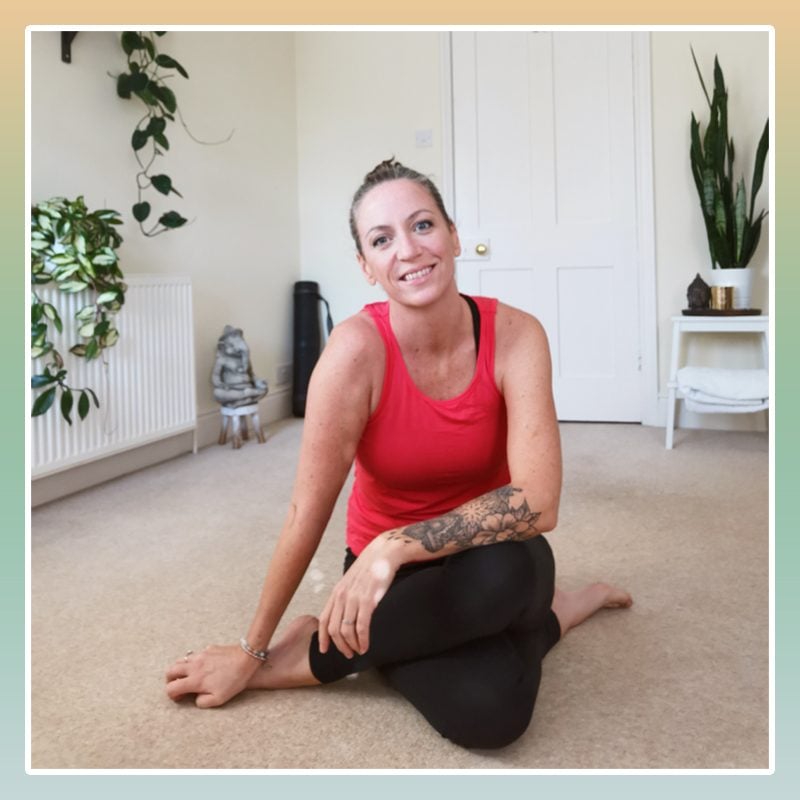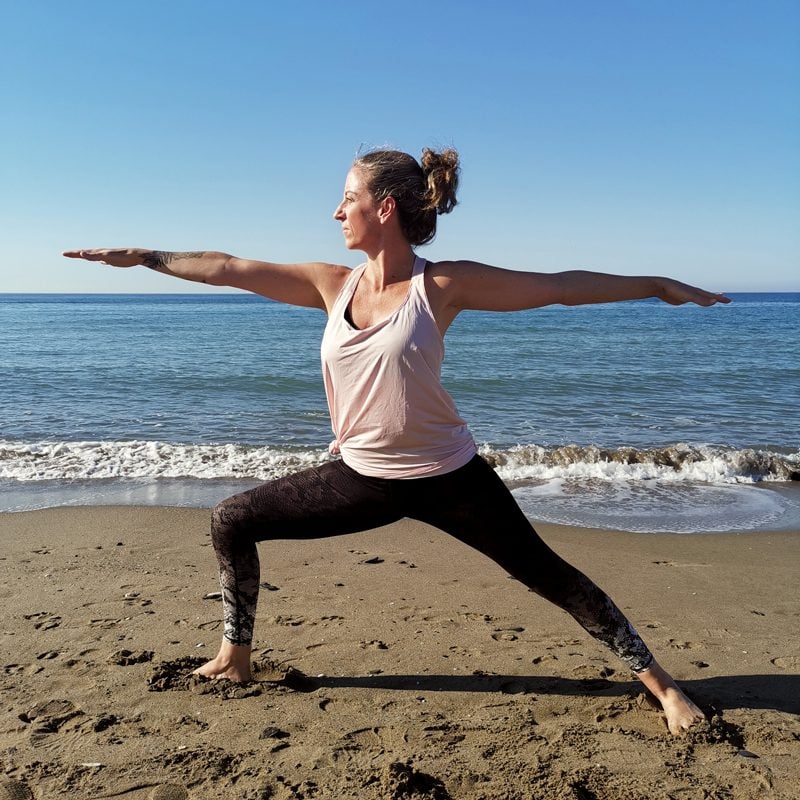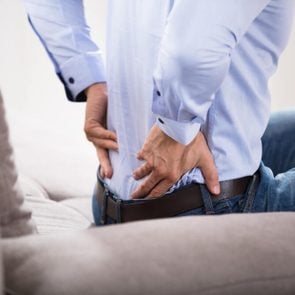I Healed My Debilitating Back Pain by Tapping Into My Emotions
Updated: Dec. 22, 2022
When her herniated disc didn’t respond to standard treatments, one woman learned the surprising link between our emotions and chronic pain—and what came next was life-changing.
Our editors and experts handpick every product we feature. We may earn a commission from your purchases.

About eight in ten Americans will experience back pain at some point in their lives—and lower back pain is the leading cause of disability in the US. Yet while it can be caused by injuries, about 85% of lower back pain cases are “non-specific”, according to research published in Frontiers in Psychology, meaning that doctors can’t identify the cause.
That’s why many may chalk up the discomfort to getting older, thinking they need to learn to live with it. Indeed, the pressure put on the lower back day in and day out does lead to degeneration that can cause pain—but stress and psychological factors can play a role in back pain too.
When Dani Fagan, 41, began experiencing agonizing back pain with no known cause, she tried many different treatments and approaches. What she eventually discovered about her pain not only surprised her but also set her on a new path to health and happiness.
A Bone Health Doctor Just Listed the 12 Best Yoga Poses to Strengthen Bones
From bad to worse
I didn’t have an injury or a specific event that caused an explosion of pain. Instead, my back pain started as muscle aching and tightness in my lower back. But then sitting up started to hurt, and standing for too long would get painful. It progressively got worse until I couldn’t bend over. Simply sitting in a chair became excruciating.
Since I couldn’t sit at a desk, I had to lie down to work. If I needed to stand in line for a while, like at an airport, I needed a wheelchair because I couldn’t stand for very long. Simple movements—leaning down to put on my socks or reaching up to get the sugar out of the cupboard—would cause insane amounts of pain. The muscles in my back felt constricted and stiff, like rocks. One side was tighter than the other which made me tilt to one side and limp when I walked.
One night while I was in bed, sound asleep, an intense pain startled me awake. I was lying in bed, so I knew I didn’t pull something or slip anything. Then the next day it felt as if I had a knife in my back. It was just horrific.
9 Signs Your Back Pain Is Actually an Emergency
Short-term solutions
I went to see a doctor for the first time in 2015, about a month or two after the pain started. I’ve had pretty bad health anxiety my whole life, so I was quick to see someone. But I only learned that I had lower back pain, which is incredibly common in people as they age (though I was only 35 at the time).
The doctor gave me pain medications and steroid injections, neither of which was a long-term fix. After a few explosive pain episodes, I went to the emergency room, where I received an injection of muscle relaxants, but those effects eventually wore off.
Does Dry Needling Work? 2 Doctors Share This Treatment’s Potential to Heal and Reduce Pain
Dealing with my diagnosis
As the months passed, I continued to see different doctors and specialists at different hospitals, searching for a solution. After about six months, I got an MRI that found a herniated disc in my lower back, which meant one of the discs in my vertebrae was pushed out of alignment with the rest of my spine.
“That’s it! That’s what is causing your pain,” the doctors said. I was relieved—if it was a herniated disc, they would be able to fix it. Or so I thought. I was refused surgery by multiple surgeons, all of whom said that it wasn’t bad enough to operate. The disc wasn’t pressing on a nerve; it was just a minor slip.
I was completely flummoxed. They were telling me that the herniated disc was the cause of my excruciating pain, but at the same time saying that it wasn’t bad enough to fix. It was awful and so frustrating.
[Editor’s note: Herniated discs are common. They are sometimes incidental findings on an MRI and are not always the true source of pain, which can lead to unnecessary surgery.]
Nothing left to lose
I continued to see doctors and visit the emergency room regularly for medications and injections to manage the pain. There was one point at which I was giving myself steroid injections every 10 days at home just so I would be able to live my life and do my job.
One day, I saw a Facebook post from a friend who was experiencing a bad back. One of her friends had commented on the post, asking if she had read the book Healing Back Pain: The Mind-Body Connection by John E. Sarno, MD. It may help, her friend said.
Needless to say, I was skeptical. Read a book and fix your back pain? I didn’t believe it, but I was so desperate and had done everything else. I was out of options, so I bought the book, which was first published in 1991.
‘Lots of People’ Find Relief in Brittney Griner’s Same Pain Treatment, a UCLA Doctor Says
Repressed emotion’s role in back pain
Reading Dr. Sarno’s book was like reading my own autobiography. I was blown away. His theory is that, depending on your personality traits, you may harbor and repress strong emotions, like anger. This means you’re essentially swallowing your feelings.
If you don’t deal with, address, or at least acknowledge those feelings, your body may find another way to manifest this emotion.
Now, imagine you are a great big vat of boiling water. Keep adding trauma and struggles to the pot, and it’ll eventually overflow. When that happens, you’ll get some sort of debilitating ailment—the most common of which is lower back pain. That is, your nervous system gets so jacked up from all of your repressed emotions, putting you in a constant state of fight or flight, that it creates symptoms.
A growing body of research overwhelmingly supports this mind-body connection, too. One review published in the Journal of Psychosomatic Research looked at 15 recent studies that suggest maladaptive (poor) emotional regulation is an important risk factor for developing otherwise unexplained chronic physical pain.
All of this really resonated with me. I was absolutely someone who repressed my emotions. Dr. Sarno also said that if this is the cause of your pain, you may find that chiropractic work and physical therapy will make it worse, which was the case for me.
What Is EMDR? How This Therapy Is Used for PTSD
The link between emotions and pain
At this point, I started to think back to when my pain began, if there was anything that caused my pot to boil over. That was when I remembered that I had been dealing with other health issues and things going on with my family. And then there was the threat that came just before my pain.
My neighbors’ dog had been barking incessantly for four nights in a row. They were squatters, these people living in the house next door (and the reason we moved soon after).
I went over and asked if they could put the dog inside the house because it was keeping us awake. In response, the woman said she was going to murder me and put a curse on my family. I had totally forgotten about this, but right afterward, my pain started.
8 Weird Symptoms You Didn’t Know Were Linked to Stress

The mind-body connection
After reading the book, I tried to find a practitioner who taught mind-body medicine, which was nearly impossible. So instead, I went down an Internet rabbit hole, trying to get more information.
I tried incorporating some of Dr. Sarno’s main principles into my daily life, such as returning to a normal level of movement without fear. So I went back to yoga classes at the gym with a new mindset: My body wasn’t broken, and if I didn’t obsess over the pain then it would get better.
I did find some relief, but it took me the better part of two years to find Nicole Sachs, a psychotherapist who worked with Dr. Sarno. She taught a method called JournalSpeak, a type of expressive writing that you do as a daily practice. Every day, you offload all the emotions and stress you’re feeling onto paper, then you throw the paper away and meditate on how you feel.
The journaling method taught me how to finally feel my emotions instead of suppressing them. After about two months of doing it, I began having stretches of pain-free days.
How to Keep a Gratitude Journal, With 16 Prompts to Help You Get Started
Living essentially pain-free and thriving
Today I do have flare-ups of pain occasionally, especially if I’m feeling particularly stressed or harboring emotions. But these episodes are quite rare.
I understand what my emotions are doing and what will trigger a response for me. Now, I meditate fairly regularly and practice and teach yoga, which I think is a great manifestation of the mind-body approach.
I also try to get the word out about this approach to healing chronic pain through my website My TMS Journey.
It’s been well known for a long time that if you have a stressful day, you might get a migraine or a tummy ache. Or if you’re nervous, you’ll sweat or have a panic attack.
Those are physical manifestations of emotional problems, and this is simply applying that same idea to chronic pain. You just have to listen to what your body is telling you and it can open up a whole new pain-free, anxiety-free existence.
—As told to Alyssa Sybertz
- Practicing This Feeling Could Actually Help You Live Longer
- 5 Easy Steps to Reset Your Gut Health, Says a Doctor
- 26 Anti-Aging Secrets That Could Add Years to Your Life
- 12 Sustainable Wellness Gifts This Holiday Season
Additional writing and reporting by Leslie Finlay.














